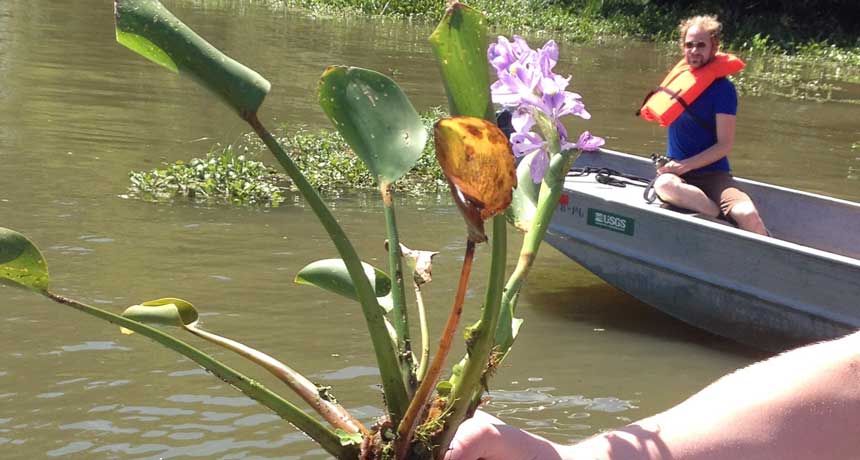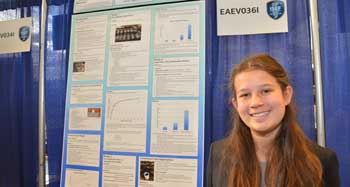Using plants to solve environmental problems
A science project might be right outside your door

This water hyacinth might look pretty, but a teen scientist showed it can choke off access to oxygen in the water, suffocating local organisms.
J. Raloff/SSP
PITTSBURGH, Pa. — The fishing wasn’t so good anymore. Drake Bergeron, 17, heard stories from his father about fishing and hunting for crawfish in the lakes and streams around his hometown of Lafayette, La. “The biggest crawfish he ever caught was 11 inches [27 centimeters] head to tail,” the teen recalls. That’s almost five inches larger than average.
But now, when Drake and his father baited their fish hooks or hunted crawfish, they often found the water chock full of greenery. Huge rafts of purple-flowered plants crowded the surface. “You can’t even touch the water,” the junior at Ovey Comeaux High School complains. And under the water, there were no crawfish to be found. The teen’s frustrations gave him an idea for a science project — probe how those floating plants were affecting the water underneath.
He’s not the only teen to use environmental concerns as the motivation for a research project. Many high school students find inspiration from issues affecting their local ponds, wetlands or gardens. One may want to tackle world hunger. Another to reduce fertilizer runoff. Drake simply wanted better fishing.
Inspirations like these brought more than 1700 students here to the Intel International Science and Engineering Fair. Created by Society for Science & the Public and sponsored by Intel, this competition brought students together from around the world to show off their science fair projects. (SSP also publishes Science News for Students and this blog).
Fighting a water weed
The mats of greenery that Drake and his father encountered are water hyacinths (Eichhornia crassipes). As perennials, they grow through the spring and summer. Their flowers and leaves die in the fall and winter. But the roots of the plant go on living. Next year they’ll resume growing and bloom again.
Water hyacinths are an invasive species. That means they are not native to this region and are taking over their new environment like weeds. Since people brought them to the United States from South America, the plants have spread rapidly through the ponds and rivers, including those in Drake’s part of Louisiana. Fueling their growth is fertilizer.
When farmers put a lot of fertilizer onto their fields, some of it will run off during rains, dribbling into lakes, ponds and streams. This fills them with extra nutrients. The fast-growing hyacinths take advantage of this fertilizer feast. Before long, they can blanket a waterway’s surface.
But when the flowers and leaves of these plants die back in the winter, bacteria will begin to digest them. As the microbes work away, they use up the oxygen in the water. This is called eutrophication. Without enough oxygen, fish can’t survive in the area. And this has been ruining Drake’s chances of finding the crawfish he likes to catch.
Were the rafts of hyacinths depleting oxygen in the water? To find out, the teen measured oxygen levels in samples of water where the water weed had been growing and where it hadn’t. Drake showed that when a pond is full of water hyacinths, its oxygen levels drop to very low levels. While his findings alone won’t bring the fish back, the teen hopes that he can use his data to educate local farmers. If they understand the impacts of fertilizer runoff, he might persuade them to manage their use of these crop nutrients better. Cutting back on the nutrients might hold the growth of water hyacinths in check so that they don’t overpopulate. And that just might persuade the fish to return.
Giving soil a little sugar
Michelle Kummel, 14, was also worried about eutrophication. The Colorado Springs freshman at William J. Palmer High School in Colorado began research during middle school. She studied Fountain Creek, a stream near her home. “It was rather polluted,” she found. And she, like Drake, was concerned about fertilizer runoff. In her case, Michelle focused on nitrates — chemicals made of nitrogen atoms bounds to oxygen atoms found in many fertilizers. She knew that too many nitrates could foster harmful blooms of algae. Later, when the algae died, microbes would digest them. As they did, these growing communities of microbes would scarf up much of the oxygen in the water.

The teen decided to find out if she could increase how fast microbes digested nitrates in wetland soil. In science class, she had learned how organisms produce energy using sugar. And this gave her a sweet idea. Maybe adding a little extra glucose (a simple sugar) to soil might encourage bacteria to break down more soil nitrates.
Michelle took water samples and soil, then measured how quickly the bacteria in that soil broke down the nitrates. Then she added a solution to the soil — water with 200 parts of glucose for every 1 million parts of water. The teen showed that a little extra sugar made the microbes in soil reduce the nitrates three times faster.
Zap for a happy radish
People always seem to want things bigger, better and faster, muses Ivan Mulero. The senior attends Colegio Beato Carlos Manuel Rodriguez in Bayamon, Peurto Rico. Living in a rural area, he’s always been a farmer, by nature. “I have lemons, coconuts, avocados. I raise animals, too.” Naturally, when he looked for a science project, Ivan thought about boosting plant growth. People are hungry all over the world. “If you could make plants grow faster,” he reasoned, it might allow farmers to grow more food in less time.
All cells rely on chemical processes to live. Tiny electrical charges drive those processes. So, applying a small amount of electricity to a plant might speed its growth, Ivan reasoned. The result: taller plants in less time.
He divided 60 small radish plants between six pots, with 10 plants per pot. Then, for 20 minutes each day he applied 18 volts of electricity (from two 9-volt batteries, about enough to power a cordless hand drill) to three of the pots. He left the other pots untouched as a control. As he treated the plants for 21 days, Ivan measured the plants with a ruler. At the end of the tests he repeated the entire experiment again with a second group of radishes.
With a little jolt of electricity, radishes grew 20 percent taller than those that were not zapped. This signaled they were growing faster. If this growth boost also works on a larger scale, Ivan would like to see people use small amounts of electricity from solar panels to increase their crop yields. That might produce more food for hungry people.
These are only three of the many projects that took inspiration from a teen scientist’s local environment. Their work may have stemmed from some personal interest, but each young researcher eventually hopes to make a bigger impact.
Research often satisfies more than just personal curiosity. It’s also can improve our understanding of the Earth as a whole. And that matters because “It’s the planet we live on,” Drake says.
Follow Eureka! Lab on Twitter
Power Words
(for more about Power Words, click here)
control A part of an experiment where there is no change from normal conditions. The control is essential to scientific experiments. It shows that any new effect is likely due only to the part of the test that a researcher has altered. For example, if scientists were testing different types of fertilizer in a garden, they would want one section of it to remain unfertilized, as the control. Its area would show how plants in this garden grow under normal conditions. And that give scientists something against which they can compare their experimental data.
denitrification The process by which bacteria digest nitrates — nitrogen atoms bound with oxygen — to produce two nitrogen atoms bound together. This process can help remove harmful nitrate pollution from surface waters. The process is sometimes also harnessed to clean up wastewater.
eutrophication The process by which a body of water becomes full of nutrients, which then stimulates the excessive growth of plants and algae. When these organisms die, bacteria break them down. But this bacterial activity can temporarily use up much of the water’s dissolved oxygen. Without too little oxygen, animals can suffer — even suffocate. In short order, a eutrophic ecosystem can collapse.
fertilizer Nitrogen and other plant nutrients added to soil, water or foliage to boost crop growth or to replenish nutrients that removed earlier by plant roots or leaves.
glucose A simple sugar that is an important energy source in living organisms. It is half of the molecule that makes up table sugar (also known as sucrose).
invasive species (also known as aliens) A species that is found living, and often thriving, in an ecosystem other than the one in which it evolved. Some invasive species were deliberately introduced to an environment, such as a prized flower, tree or shrub. Some entered an environment unintentionally, such as a fungus whose spores traveled between continents on the winds. Still others may have escaped from a controlled environment, such as an aquarium or laboratory, and begun growing in the wild. What all of these so-called invasives have in common is that their populations are becoming established in a new environment, often in the absence of natural factors that would control their spread. Invasive species can be plants, animals or disease-causing pathogens. Many have the potential to cause harm to wildlife, people or to a region’s economy.
microbe Short for microorganism. (see microorganism)
microorganism A living thing that is too small to see with the unaided eye, including bacteria, some fungi and many other organisms such as amoebas. Most consist of a single cell.
nitrate An ion formed by the combination of a nitrogen atom bound to three oxygen atoms. The term is also used as a general name for any of various compounds formed by the combination of other atoms in a nitrate group.
parts per million (billion or trillion) Frequently abbreviated as ppm (or ppb or ppt), it is a measure of the number of units of some material that it mixed into another. The units should be the same (or equivalent) for both materials. The term is used to describing extremely small concentrations of one chemical dissolved in another. For example, a solution of 300 parts per billion of sodium in water would mean that there are 300 sodium atoms for every billion water molecules.
perennial (in botany) A plant that lives for many years. Some may die back in harsh weather (extreme heat or cold), but then come back months later when conditions improve.
respiration The process by which organisms produce energy from sugars, usually by taking in oxygen and releasing carbon dioxide.
Society for Science and the Public(or SSP) A nonprofit organization created in 1921 and based in Washington, D.C. Since its founding, SSP has been not only promoting public engagement in scientific research but also the public understanding of science. It created and continues to run three renowned science competitions, including the Intel International Science and Engineering Fair (initially launched in 1950). SSP also publishes this blog and award-winning journalism in Science News (launched in 1922), and Science News for Students (created in 2003).
wetland A low-lying area of land either soaked or covered with water. It hosts plants and animals adapted to live in, on or near water.







